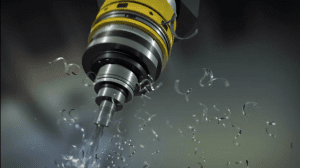10 Ways SOLIDWORKS CAM and CAMWorks are Crucial to Your Manufacturing Process
 Since the 2018 release of SOLIDWORKS, users on subscription have CAM capabilities within their SOLIDWORKS environment. With this integration of SOLIDWORKS CAM, users can now complete the design and manufacturing process within one system. Design changes, file formats, and file compatibility are just a few issues we commonly deal with when working between two independent CAD and CAM systems. Having an integrated solution like SOLIDWORKS CAM eliminates those issues and streamlines the design to manufacturing process.
Since the 2018 release of SOLIDWORKS, users on subscription have CAM capabilities within their SOLIDWORKS environment. With this integration of SOLIDWORKS CAM, users can now complete the design and manufacturing process within one system. Design changes, file formats, and file compatibility are just a few issues we commonly deal with when working between two independent CAD and CAM systems. Having an integrated solution like SOLIDWORKS CAM eliminates those issues and streamlines the design to manufacturing process.
CAMWorks is a complete CAM solution including features such as full 3D simultaneous surfacing, multi-axis, mill turn, and wire EDM just to name a few. Additionally, SOLIDWORKS CAM and CAMWorks share the same interface making it a simple transition from one product to another.
SOLIDWORKS CAM offers two modules: SOLIDWORKS CAM Standard and SOLIDWORKS CAM Pro.
SOLIDWORKS CAM Standard (available to all SOLIDWORKS 2018 subscription users) includes 2.5 axis toolpathing capabilities allowing for basic contouring, facing, pocketing, and various drilling, and tapping operations. Also included in SOLIDWORKS CAM Standard are limited 3 axis surfacing options including area roughing, flats, and constant z toolpathing. SOLIDWORKS CAM Standard also only allows for all toolpathing to be completed on a single part file.
SOLIDWORKS CAM Professional extends capabilities to allow for assembly file programming, high-speed toolpaths utilizing Volumill, as well as configurations. Additional benefits include 3+2 indexing and basic turning. If your manufacturing process requirements and capabilities move beyond what SOLIDWORKS CAM Standard and Professional offer, you can move into the CAMWorks environment.
Now that you know a little more about the products, below are 10 ways CAM and CAMWorks are crucial to your manufacturing process.
#1. Knowledge Based Machining
With the Tech Database available in both SOLIDWORKS CAM and CAMWorks, users have the ability to take full advantage of Knowledge Based Machining. This capability allows companies to customize the software to work specifically for what their manufacturing process requires. The Tech DB stores all custom machining strategies as well as tooling and machine information that can easily be applied to all components that are pushed through the manufacturing process. This streamlines the programming process by eliminating redundancies during workflow. For example, if I have defined a strategy that works for part one and that same strategy works for part two…why create the same process again?
#2. Automatic Feature Recognition
SOLIDWORKS CAM and CAMWorks both utilize Automatic Feature Recognition (AFR). AFR allows the user to analyze a model and extract known prismatic features to quickly apply defined strategies reducing the time it takes to program your part. AFR is independent of the SOLIDWORKS design tree allowing for quick programming of other file types that may not contain history to the model.
#3. Advanced 3D Feature Based Machining
You don’t have to lose any automation when the geometry becomes too complex to recognize through the AFR. Simply create the multisurface features and then apply predefined strategies already created and stored in the Tech DB. This keeps the programming process simple even on complex shapes.
#4. Seamless Integration to CAD
Since SOLIDWORKS CAM and CAMWorks both share the SOLIDWORKS interface, one platform can handle all processes through the lifecycle of the part from design to manufacturing. This eliminates common problems such as design changes, file types, and compatibility issues.
#5 Full Model and Toolpath Associativity
Since you can now program directly in the environment that you CAD data was generated, when your toolpaths are applied, a direct link is created between your CAD and CAM data. Working in a CAM system independent of CAD makes it difficult to handle design changes and updates that often happen throughout the design process. With an integrated CAM system, we can easily handle these changes. If CAD updates, all CAM data applied to your CAD software will automatically update as well.
#6. High-Performance Toolpaths
With the utilization of Volumill users have the ability to leverage high-speed toolpathing for 2.5 axis and 3 axis surfacing operations. This allows for the most efficient toolpathing drastically reducing cycle time and extending tool life.
#7. Toolpath and Machine Simulation
Verifying what you’re programming reduces costs throughout the company because you are able to identify and eliminate crashes before they happen. Simulation tools let you add fixtures, clamps, and all work holding components ensuring accurate toolpathing. Simulation tools reduce scrap and protect your machines by spotting collisions before they happen.
#8. A Complete CAM Solution
Whether SOLIDWORKS CAM Standard, SOLIDWORKS CAM Pro, or CAMWorks is the right solution for you, you’ll receive product support for all applications including 2.5 axis and 3 axis milling, mill turn, 5 axis, wire EDM, and nesting. Detailed verification and simulation applications are available as well.
#9. CAD Functionality Available when Needed
With SOLIDWORKS CAM and CAMWorks, users have SOLIDWORKS 3D CAD capabilities at their disposal allowing you to easily create needed geometry or modify existing data for toolpathing. Users can leverage SOLIDWORKS capabilities to assist with the programming process. Part configurations, the ability to work within assembly files, and access to all SOLIDWORKS data to assist with toolpathing add to the efficiency of the system.
#10. Easy to Learn, Simple to Use
AFR and Tech DB simplify the entire programming process. Working within one interface and having a full CAM solution eliminates having to learn multiple systems and navigating multiple environments for various stages of the manufacturing process.
Related Articles
The Difference Between SOLIDWORKS CAM Software: CAM Standard Versus CAM Professional
What is the Best CAM Software to Use with SOLIDWORKS?
SOLIDWORKS CAM Software and Tolerance Based Machining
About the Author
 Jeff Reiser is an Application Engineer specializing in CAM software. Jeff is a third generation toolmaker and has over 19 years of CAM and manufacturing experience. Jeff is based out of Pittsburgh, Pennsylvania and has been part of the Fisher Unitech family since 2018.
Jeff Reiser is an Application Engineer specializing in CAM software. Jeff is a third generation toolmaker and has over 19 years of CAM and manufacturing experience. Jeff is based out of Pittsburgh, Pennsylvania and has been part of the Fisher Unitech family since 2018.

 Blog
Blog 